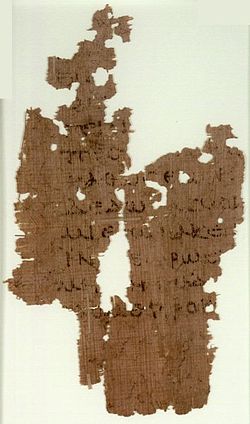Papyrus 108
| Papyrus 108 | |
|---|---|

| |
| Name | P. Oxy. LXIV 4447 |
| Text | Johannes 17,23-24; 18,1-5 |
| Sprache | griechisch |
| Datum | 3. Jahrhundert |
| Gefunden | Ägypten |
| Lagerort | Bodleian Art, Archaeology and Ancient World Library |
| Quelle | W. E. H. Cockle, OP LXIV (1998), S. 16–18 |
| Größe | 10,5 × 6,2 cm |
| Typ | Alexandrinischer Texttyp |
| Kategorie | keine |
Papyrus 108 (nach Gregory-Aland mit Sigel 108 bezeichnet) ist eine frühe griechische Abschrift des Neuen Testaments.
Beschreibung
Dieses Papyrusmanuskript des Johannesevangeliums enthält nur die Verse 17,23–24; 18,1–5. Mittels Paläographie wurde es auf das 3. Jahrhundert datiert.[1][2]
Sie enthält itazistische Fehler in Johannes 17,23 (γεινωσκη statt γινωσκη).[3]
Text
Der griechische Text des Kodex repräsentiert den Alexandrinischen Texttyp. Der Text stimmt mit Codex Sinaiticus überein.
Aufbewahrungsort
Die Handschrift wird zurzeit in der Bodleian Art, Archaeology and Ancient World Library unter der Signatur P. Oxy. 4447 in Oxford aufbewahrt.
Einzelnachweise
- ↑ INTF, Handschriftliste
- ↑ Philip W. Comfort, Encountering the Manuscripts. An Introduction to New Testament Paleography & Textual Criticism, Nashville, Tennessee: Broadman & Holman Publishers, 2005, S. 76.
- ↑ Peter M. Head, The Habits of New Testament Copyists Singular Readings in the Early Fragmentary Papyri of John, Biblica 85 (2004), S. 403.
Siehe auch
Literatur
- W. E. H. Cockle, The Oxyrhynchus Papyri LXV (London: 1998), S. 16–18.
- Peter M. Head, The Habits of New Testament Copyists Singular Readings in the Early Fragmentary Papyri of John, Biblica 85 (2004), S. 403.
Weblinks
Abbildungen
- P.Oxy.LXIV 4447 von Papyrology at Oxford’s "POxy: Oxyrhynchus Online"
- Bild von 108 recto, Joh. 17,23-24
- Bild von 108 verso, Joh. 18,1-5





